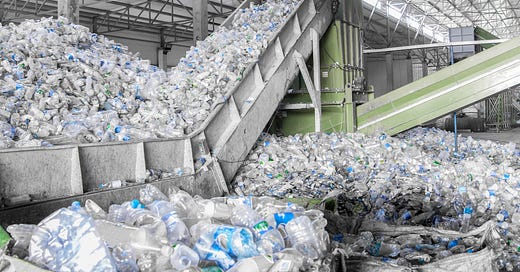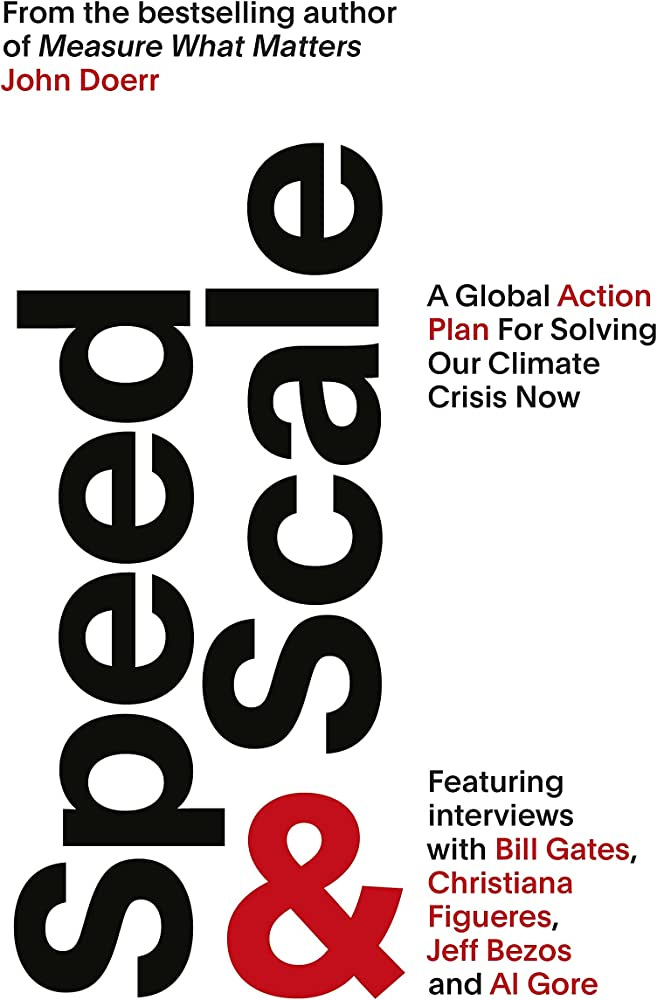BRB w/ Nathan P - Consumer Recycling, Confit Garlic Hummus, Speed & Scale
The do's and don'ts of recycling and what you should know, the best garlic hummus recipe, and John Doerr's roadmap towards a net zero future (#12).
Hi all,
Welcome back to BRB w/ Nathan P - a weekly newsletter featuring 💥1 Breakthrough, 🥘1 Recipe, and 📚1 Book on food & climate.
Before we get started, here are some highlights of food & climate in the news this week:
Opinion - What if climate change meant not doom — but abundance? (Washington Post)
Food Safety Aspects of Cell-Based Foods (Food and Agriculture Organization of the United Nations). The UN provides guidelines to help governments regulate cultivated meat - which they suggest is as safe as regular meat.
💥 Breakthrough: Consumer Recycling
Do you ever have a piece of trash in hand, looking back and forth between 3 bins, asking yourself: what the heck do I do with this? I know the feeling.
Ask no longer, my dear reader, for I have you covered.
The goal of today’s newsletter is to:
📝 recap the state of recycling for 5 key consumer materials
☑️ provide do’s and don’ts for your daily recycling
The State of the Industry: 5 key materials
We consume a lot of stuff, and throw a lot of stuff in the recycling bin. But how much of it is actually recycled?
Here are the recycling rates of 5 key consumer materials in the US, EU, and globally:
Aluminum and paper are amongst the best recycled materials, while plastic’s true recycling rate is criminally low. We have recycled less than 10% of the 7 billions of tons of plastic from the past century.
Here’s what else you should know about each of them:
🧊 Glass has an energy recovery rate of 33% when recycled, which is rather low. Reusable glass is more environmentally friendly, especially in countries like Germany where returning beer bottles for reuse is the norm.
🥫 Aluminum is one of the success stories of recycling: 95% of the energy is retrieved. When you have the option, opt for aluminum instead of plastic. Liquid Death is killing it with #DeathToPlastic.
📄 Paper can be recycled 5-7 times, since the fibers shorten at each cycle. Virgin pulp is usually added into the mix for recycled paper products.
🥤 Plastic has by far the lowest recycling rate. Much of it ends up in the ocean, the ultimate sink. The majority of that 9% is PET (#1, used in water bottles), followed by HDPE (#2, used for milk gallon jugs).
🔩 Steel has a decent recycling rate, which is important given that steel alone accounts for close to 5% of global GHG emissions. Most of this recycled steel is from automobiles.
Do’s and Don’ts
✅ Do:
Empty liquids from containers (like cans or plastic bottles)
Rinse plastics before disposing
Recycle clean, dry, non-shredded paper
Recycle batteries and e-waste in appropriate collection centers near you
Know what’s accepted in each of your community’s streams
Break down cardboard before disposing
❌ Don’t:
“Wish-cycle”: throw non-recyclable products in the bin just because you hope they’ll be recycled. These include paper cups (plastic lining = not recyclable 😔)
Recycle loose plastic bags with other plastic (only recyclable in special facilities)
Try to recycle products that have different materials fused together (like chip bags)
Crush aluminum cans: it lowers the chance they’ll be properly sorted for recycling
Recycle food-contaminated products, like the bottoms of pizza boxes
What other recycling questions do you have? Write a comment below and let me know.
🥘 Recipe: Confit Garlic Hummus
The one, the only… hummus recipe you will ever need.
Yotam Ottolenghi, the Middle Eastern chef behind this recipe, says that making “hummus is a competitive sport.” This one might take the gold🥇.
Find the recipe at the end of this newsletter. If you make it, please send pictures :)
If you drooled over that picture… why not subscribe for more?
📚 Book: Speed & Scale
John Doerr takes a pragmatic, resource-conscious, and targeted approach to develop a roadmap towards a net-zero future. He deploys his business acumen from 35 years at Kleiner Perkins towards the challenge of our time: climate change.
In Speed & Scale, he lays out a plan with 10 OKRs - Objectives and Key Results - with measurable emission reductions targets (preview below).
It is an invaluable and impactful book, inspired from John Doerr’s conversations with 100+ climate pioneers. You can track the live progress of each OKR here.
A bird’s eye view of John Doerr’s 10 OKRs:
Thank you for reading - BRB next week ✌️
🥘 Recipe: Confit Garlic Hummus
Courtesy of Yotam Ottolenghi & MasterClass
Ingredients (4 servings)
Confit Garlic Oil (makes 1 cup)
12 garlic cloves, peeled
6 thyme sprigs
1 green chili
200 ml olive oil
Salt
Hummus
60 g Tahini Sauce
12 confit garlic cloves, plus 4 tbsp Confit Garlic Oil
550 g cooked chickpeas (see Basic Chickpeas, right, or canned)
180 g to 210 g tahini paste (depending on brand)
Salt
1/4 cup lemon juice
5 tbsp plus 2 tsp ice-cold water, plus extra
1½ tbsp parsley, finely chopped
Instructions (45 mins)
Make the confit garlic oil. Combine all ingredients in a small saucepan over medium-low heat. Cover and cook until the garlic is soft and just beginning to color, about 20 to 25 minutes.
Leave the lid on, remove from the heat, and set aside for 10 minutes; the garlic will continue to cook in the heat of the oil.
Strain the oil into a clean glass jar and spoon in the garlic, thyme, and chili. Once cool, transfer everything to an airtight, sterilized jar and store at room temperature for several weeks.
Make the hummus. Set about 100 grams of the cooked chickpeas aside in a small bowl.Add the remaining chickpeas, tahini paste, 8 of the confit garlic cloves, ½ teaspoon salt, and the lemon juice to the bowl of a food processor and blitz until smooth, 2 to 3 minutes.
With the machine running, slowly drizzle in the ice water until completely smooth and aerated. You may have to add slightly more water to reach the desired texture. Taste and adjust for seasoning if necessary.
Add the parsley, 2 tablespoons of Confit Garlic Oil, and a pinch of salt to the bowl with the reserved chickpeas, and stir to combine. Set aside.
Transfer the hummus to a shallow platter and smooth it out with the back of a spoon, creating a slight well in the center. (It’s okay if the hummus is a little runny; hummus will set as it cools.)
Spread the Tahini Sauce into the well, then spoon the herbed chickpea mixture over the top of the tahini. Top the dish with the remaining confit garlic cloves along with some of the aromatics in the jar (thyme and chili). Finish with a drizzle of Confit Garlic Oil.
About Me
Hi there! My name is Nathan Paumier - I’m an avid reader, food enthusiast, and climate optimist. I started this newsletter after frequent questions on food tech, reading recommendations, and my secret recipes.
Want to get in touch or chat further? Any feedback or things you’d like to see more of?
Forwarded this email?
Subscribe below to receive an email from me every week.
No spam, just quality ingredients.










Excellent recycling tips! What about composting? There's a concerted effort in Brooklyn now. They have composting bins on street corners accessible via app (so not anyone can throw stuff in there and you're aware of what you can and cannot discard in there). The main challenge in my neighborhood is that they are always full!!